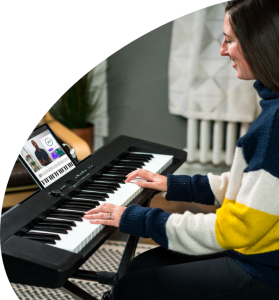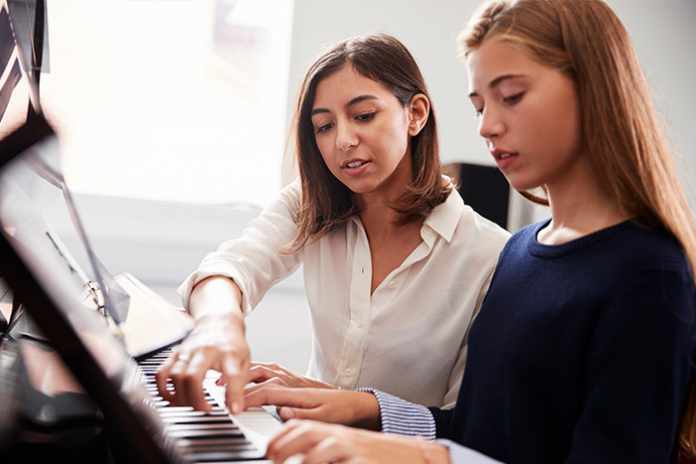The piano is a classic and versatile instrument. Anyone can learn how to play. You don’t need a specific age or gender to play the piano, and you don’t need any musical background. All you need is patience, determination, and motivation. If you have intense concentration and self-discipline, you may teach yourself how to play the piano. However, if you have a teacher to help guide you and concentrate on your studies, you will improve faster.
Table of Contents
Set up your instrument
Choose a piano or keyboard. If you are committed to learning piano, you need a piano or keyboard of your own, which you can play at home. Otherwise, it will be difficult for you to maintain a stable practice plan every day.
Adjust your bench
so that you can sit in the correct posture. Place the bar in the center of the keyboard, keeping a sufficient distance so that you can sit on the edge of the keyboard. Raise or lower the bar until your elbows are roughly level with the keyboard when you put your fingers on the keyboard.
Practice the correct position of your fingers on the keys.
When playing the piano, hold it up with both hands, as if holding an egg, and press the keys with the tip of your finger instead of the mat. Playing the piano with flat fingers is an easy habit to develop, but it will make it difficult for you to play faster and more complex music in the future.
Master the basics
Find the middle C on the keyboard. As a beginner, the middle C key is your anchor point. It is the middle key of the keyboard. It is the first white key among the three keys. There are two black keys in the middle. Place your right thumb on Middle C, and let the rest of your fingers rest on the white button to the right of Middle C.
Set up your metronome
Set up your metronome and practice the C major scale. To play the entire C major scale, you must first play the first three notes you played when you found the middle C, C, D, E. Now, instead of playing F with your ring finger, hide your thumb under your three fingers, then slide your hand down and play F with your thumb. Now you can play the rest of the scale with your four fingers. G, A, B, and then back to C, another octave higher.
Relationship between notes.
Try other scales to learn the relationship between notes. Once you have mastered the C major scale, you can continue to learn different scales. Some scales use only white keys, while others use white and black keys. As with the C major scale, set the metronome to slow speed and gradually increase the speed.
Practice the scale with your left and right hands
The scale played with the left-hand uses the same notes as the scale played with the right hand, but everything is reversed. When you play a scale with your left hand, your left hand is a mirror image of your right hand.
Identify the octave on your piano.
When you play the C major scale, you have found your first octave-this scale starts and ends on the same note, one octave apart. If you look at your keyboard, you will find that the same key arrangement pattern is repeated. The same letter repeats 12 notes from one end of the keyboard to the other. There are seven white notes (C, D, E, F, G, A, B) and five black notes (C-sharp/D-flat, D-sharp/E-flat, F-sharp/G -Falling tone, G-sharp/A-Falling tone, and A-sharp/B-Falling tone).
Pick up the basics of reading sheet music.
You don’t have to know how to read scores to play the piano-some of the greatest pianists use their ears to play. However, learning how to read scores allows you to learn and play more works faster.
Try to play a basic melody with your right hand.
Most beginner piano students start with simple folk melodies, such as “flickering little stars” or “hot cross bag.” However, many other simple themes can be found in more popular modern songs.
Use chords to add depth to your music.
Chord means that three or more notes are played together. Some of the most common chords are triads-chords with three letters. To form a major triad, you have to start with the first note of the scale and play every other note in the ranking.
Try Hanon exercises
Try Hanon exercises to increase the strength and flexibility of your fingers. Since the end of the 19th century, piano teachers used Hanon practice to help students’ fingers become more robust and better at playing the piano.
Develop your skills
Learn some simple songs to increase your familiarity with the instrument. Once you are familiar with the keyboard and can play the scales without error, you can graduate to learn fundamental music. You can play songs that are already relatively simple, or you can find beginner arrangements for more complex pieces.
Get in the habit of practicing every day. To get the maximum training effect and make faster progress, daily practice is essential. Young children may only be able to practice for 10 or 15 minutes a day. However, if you are an older student or adult, try to practice for at least 30 minutes a day. Professional musicians practice many hours a day.
Use music theory books to learn to read music notation. Music theory books can help you advance your understanding of music and improve your vision and ability to read music symbols. You can find these books online or in music stores.
Hire a piano teacher
Hire a piano teacher for more targeted guidance. Working with a teacher can make you progress faster. An experienced piano teacher will notice some minor problems and correct them before they become entrenched. The piano teacher also helps to encourage and motivate you to succeed.

If your study is self-study, you can try the piano app. You can download some apps on your smartphone or tablet to teach you how to play the piano. Some of these apps are more organized than others, so you may want to try multiple apps to decide which one you like best.
Also read: how to make a hot toddy



















